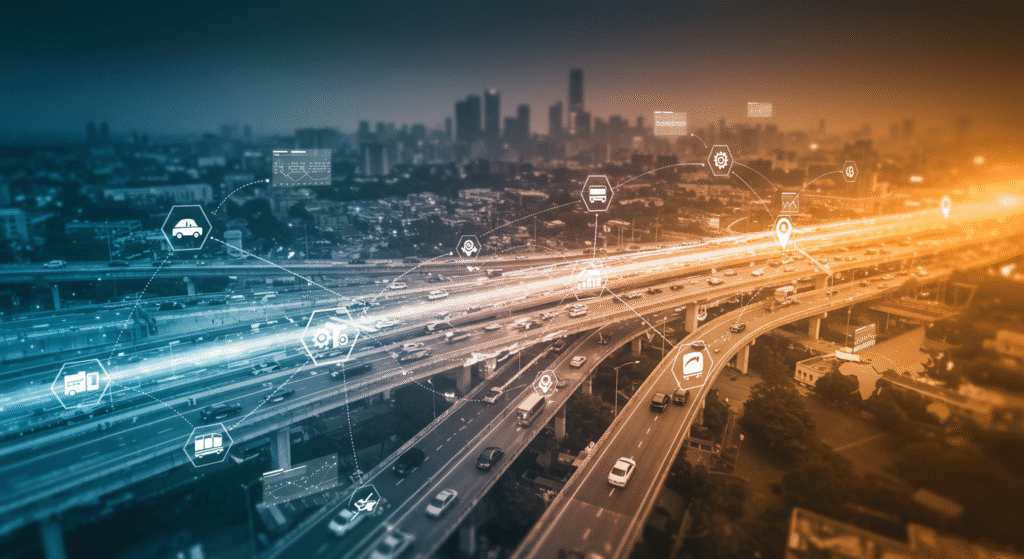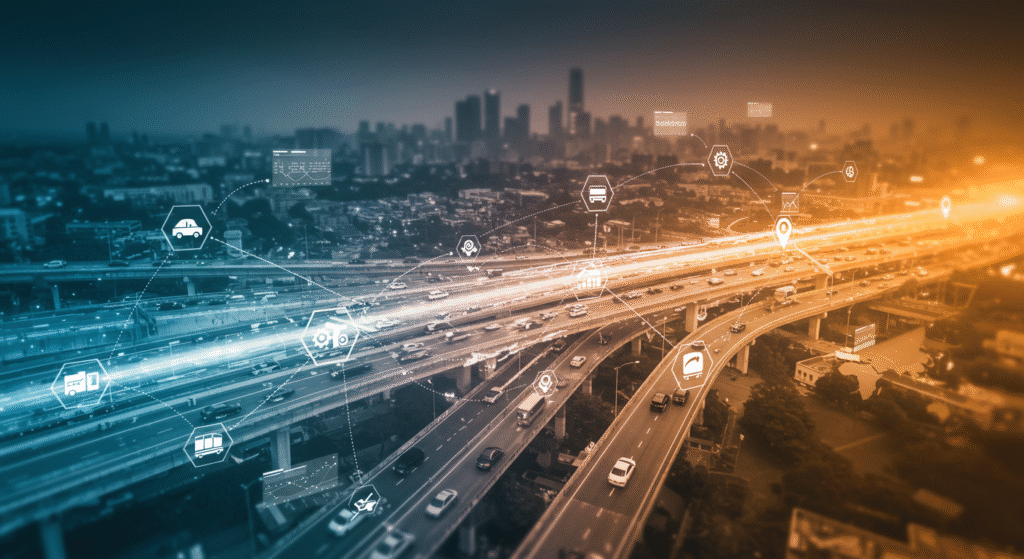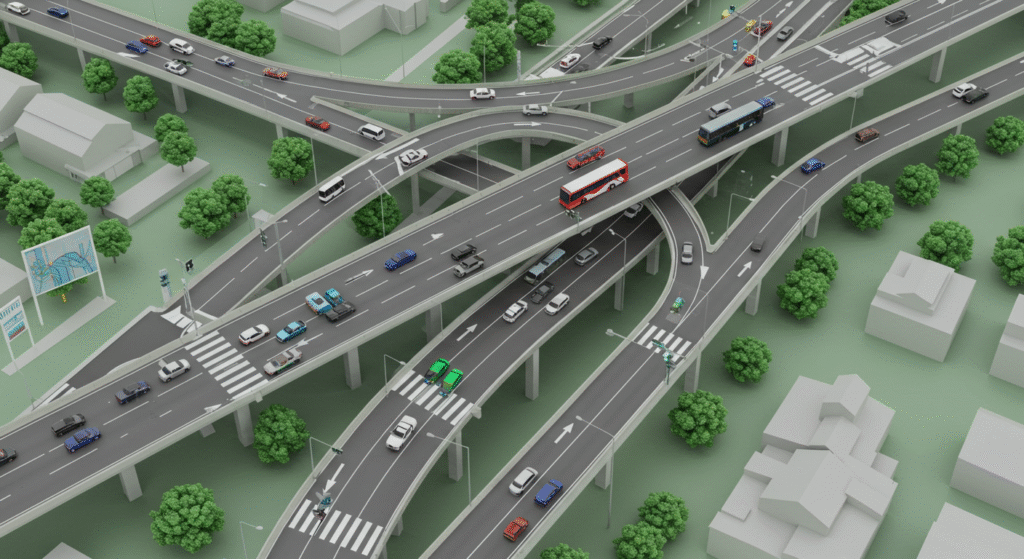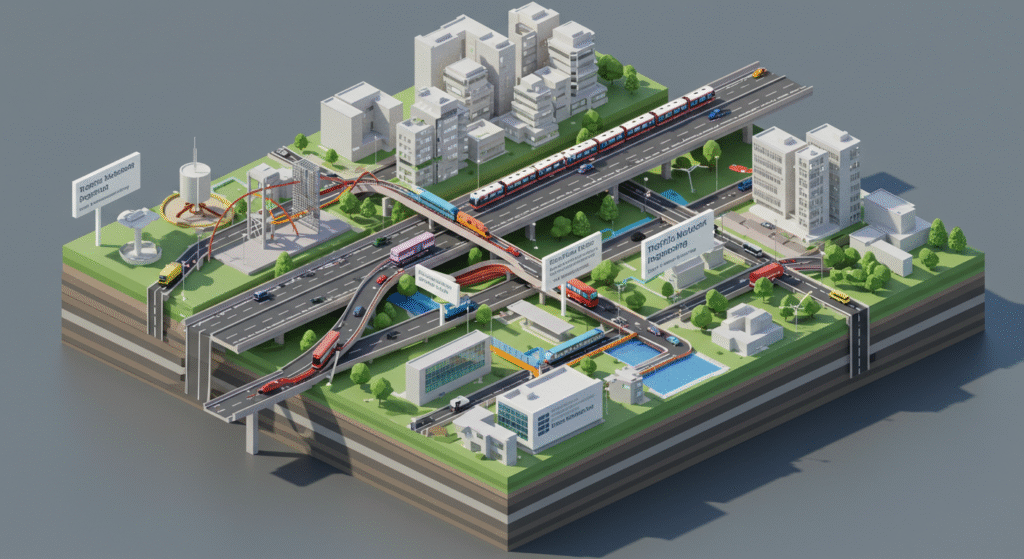Transportation Network Engineering: A Comprehensive Overview

Transportation Network Engineering
Table of Contents
- Introduction to Transportation Network Engineering
- 1.1. Definition and Scope
- 1.2. Historical Development
- 1.3. Importance in Modern Society
- Road Network Engineering
- 2.1. Design Principles
- 2.2. Highway and Freeway Systems
- 2.3. Urban Road Networks
- 2.4. Traffic Management Systems
- Public Transit Systems
- 3.1. Bus and Coach Networks
- 3.2. Rail Transit Systems
- 3.3. Subway and Metro Systems
- 3.4. Ferry and Water Transit
- Railway Network Engineering
- 4.1. Passenger Rail Systems
- 4.2. Freight Rail Networks
- 4.3. High-Speed Rail
- 4.4. Maintenance and Safety
- Airport and Aviation Engineering
- 5.1. Airport Design and Layout
- 5.2. Runway and Taxiway Systems
- 5.3. Terminal Design and Operations
- 5.4. Air Traffic Control Systems
- Port and Maritime Engineering
- 6.1. Seaport Design and Operations
- 6.2. Container Terminals
- 6.3. Navigation Channels and Dredging
- 6.4. Marine Safety and Security
- Smart Transportation Systems
- 7.1. Intelligent Transportation Systems (ITS)
- 7.2. Internet of Things (IoT) in Transportation
- 7.3. Autonomous and Connected Vehicles
- 7.4. Big Data and Analytics in Transportation
- Transportation Network Planning and Management
- 8.1. Strategic Planning and Policy
- 8.2. Network Optimization Techniques
- 8.3. Demand Forecasting and Modeling
- 8.4. Public-Private Partnerships (P3)
- Traffic Engineering and Management
- 9.1. Traffic Flow Theory
- 9.2. Signal Control and Optimization
- 9.3. Incident Management and Response
- 9.4. Congestion Pricing and Demand Management
- Transportation Safety and Security
- 10.1. Road Safety Measures
- 10.2. Public Transit Security
- 10.3. Railway Safety Standards
- 10.4. Aviation and Maritime Security
- Environmental Impact and Sustainability
- 11.1. Emissions and Air Quality
- 11.2. Green Transportation Initiatives
- 11.3. Sustainable Infrastructure Design
- 11.4. Climate Change Adaptation
- Case Studies and Real-World Applications
- 12.1. Successful Transportation Projects
- 12.2. Lessons from Past Failures
- 12.3. Emerging Trends and Innovations
- 12.4. Global Best Practices
- Challenges and Future Trends
- 13.1. Population Growth and Urbanization
- 13.2. Technological Advancements
- 13.3. Funding and Investment
- 13.4. Globalization and International Cooperation
- Conclusion
- 14.1. Summary of Key Points
- 14.2. The Evolving Role of Transportation Network Engineering
- 14.3. Encouragement for Future Innovations
1. Introduction to Transportation Network Engineering

1.1. Definition and Scope
Transportation Network Engineering encompasses the planning, design, and management of transportation systems to ensure efficient, safe, and sustainable movement of people and goods. It involves a multidisciplinary approach, integrating civil engineering, urban planning, economics, and technology.
1.2. Historical Development
The development of transportation networks dates back to ancient times, with early roads and waterways facilitating trade and cultural exchange. Over centuries, advancements in technology have led to the creation of railways, highways, and air travel, transforming global connectivity.
1.3. Importance in Modern Society
Transportation networks are the backbone of modern society, enabling economic growth, social interaction, and access to essential services. Efficient transportation systems are crucial for urban development, environmental sustainability, and emergency response.
2. Road Network Engineering
2.1. Design Principles
Road network design involves geometric design, ensuring safety, efficiency, and accessibility. Key principles include horizontal and vertical alignment, drainage, and pavement design.
2.2. Highway and Freeway Systems
Highways and freeways are designed for high-speed traffic, with features like controlled access points and grade-separated intersections to minimize congestion and enhance safety.
2.3. Urban Road Networks
Urban road networks require careful planning to accommodate dense populations and mixed traffic. Features include traffic signals, public transit lanes, and pedestrian infrastructure.
2.4. Traffic Management Systems
Intelligent traffic management systems use real-time data and technology to optimize traffic flow, reduce congestion, and manage incidents effectively.
3. Public Transit Systems

3.1. Bus and Coach Networks
Bus networks provide flexible and cost-effective transportation, with routes and schedules designed to meet urban and regional mobility needs.
3.2. Rail Transit Systems
Rail transit systems, including subways and light rail, offer efficient and high-capacity transportation solutions for urban areas.
3.3. Subway and Metro Systems
Subway systems are critical for large cities, providing rapid transit and reducing reliance on personal vehicles.
3.4. Ferry and Water Transit
Ferry and water transit systems are vital for coastal and riverine regions, offering an alternative to road and rail networks.
4. Railway Network Engineering
4.1. Passenger Rail Systems
Passenger rail systems connect cities and regions, providing efficient and comfortable travel options.
4.2. Freight Rail Networks
Freight rail networks are essential for transporting goods, supporting economic activities and global supply chains.
4.3. High-Speed Rail
High-speed rail systems revolutionize land travel, offering fast and efficient connections over long distances.
4.4. Maintenance and Safety
Regular maintenance and strict safety protocols ensure the reliability and safety of railway operations.
5. Airport and Aviation Engineering

5.1. Airport Design and Layout
Airport design focuses on functionality, safety, and passenger experience, with considerations for runways, terminals, and security.
5.2. Runway and Taxiway Systems
Runway and taxiway design ensures safe and efficient aircraft movement, with features like lighting and signage.
5.3. Terminal Design and Operations
Airport terminals are designed to handle passenger flow, baggage handling, and security screening efficiently.
5.4. Air Traffic Control Systems
Air traffic control systems manage aircraft movements, ensuring safe takeoffs, landings, and en-route operations.
6. Port and Maritime Engineering
6.1. Seaport Design and Operations
Seaports are designed to handle cargo and passenger ships, with facilities for loading, unloading, and storage.
6.2. Container Terminals
Container terminals optimize cargo handling, using advanced technologies for efficient operations.
6.3. Navigation Channels and Dredging
Navigation channels require regular dredging to maintain depth and ensure safe maritime traffic.
6.4. Marine Safety and Security
Marine safety involves measures to prevent accidents, while security ensures protection against potential threats.
7. Smart Transportation Systems

7.1. Intelligent Transportation Systems (ITS)
ITS integrate advanced technologies to improve transportation efficiency, safety, and sustainability.
7.2. Internet of Things (IoT) in Transportation
IoT enables real-time data collection and analysis, enhancing traffic management and user experience.
7.3. Autonomous and Connected Vehicles
Autonomous and connected vehicles represent the future of transportation, offering improved safety and efficiency.
7.4. Big Data and Analytics in Transportation
Big data analytics provide insights for optimizing transportation networks, predicting demand, and managing operations.
8. Transportation Network Planning and Management
8.1. Strategic Planning and Policy
Strategic planning involves long-term visioning and policy-making to guide transportation development.
8.2. Network Optimization Techniques
Optimization techniques improve network efficiency, reducing costs and environmental impact.
8.3. Demand Forecasting and Modeling
Demand forecasting uses statistical models to predict future transportation needs, informing planning decisions.
8.4. Public-Private Partnerships (P3)
P3 models leverage private-sector expertise and funding to deliver transportation projects efficiently.
9. Traffic Engineering and Management

9.1. Traffic Flow Theory
Understanding traffic flow dynamics is essential for designing and managing road networks effectively.
9.2. Signal Control and Optimization
Traffic signal control systems optimize traffic flow, reducing congestion and improving safety.
9.3. Incident Management and Response
Effective incident management minimizes the impact of accidents and disruptions on traffic flow.
9.4. Congestion Pricing and Demand Management
Congestion pricing and demand management strategies aim to reduce traffic congestion by influencing travel behavior.
10. Transportation Safety and Security
10.1. Road Safety Measures
Road safety measures include infrastructure design, traffic laws, and public awareness campaigns.
10.2. Public Transit Security
Ensuring safety and security in public transit systems is crucial for user trust and system reliability.
10.3. Railway Safety Standards
Railway safety standards cover equipment, operations, and emergency procedures to prevent accidents.
10.4. Aviation and Maritime Security
Aviation and maritime security focus on preventing threats and ensuring safe operations in airports and ports.
11. Environmental Impact and Sustainability

11.1. Emissions and Air Quality
Transportation contributes significantly to air pollution, necessitating strategies to reduce emissions.
11.2. Green Transportation Initiatives
Green transportation initiatives promote the use of electric vehicles, biofuels, and non-motorized transport.
11.3. Sustainable Infrastructure Design
Sustainable design considers environmental impact, using materials and practices that minimize harm.
11.4. Climate Change Adaptation
Transportation networks must adapt to climate change impacts, such as sea-level rise and extreme weather events.
12. Case Studies and Real-World Applications
12.1. Successful Transportation Projects
Examples of successful transportation projects highlight effective planning and execution.
12.2. Lessons from Past Failures
Analyzing failures provides insights into avoiding common pitfalls in transportation engineering.
12.3. Emerging Trends and Innovations
Emerging trends, such as hyperloop systems, represent the future of transportation network engineering.
12.4. Global Best Practices
Adopting global best practices ensures that transportation networks are world-class and sustainable.
13. Challenges and Future Trends
13.1. Population Growth and Urbanization
Rapid urbanization increases the demand for efficient transportation systems.
13.2. Technological Advancements
Technological advancements, like autonomous vehicles, are transforming the transportation landscape.
13.3. Funding and Investment
Securing adequate funding is critical for developing and maintaining transportation infrastructure.
13.4. Globalization and International Cooperation
Globalization necessitates international cooperation to standardize transportation systems and policies.
14. Conclusion
14.1. Summary of Key Points
Transportation Network Engineering is a vital field that shapes the connectivity and productivity of societies. By integrating advanced technologies, addressing environmental concerns, and adopting sustainable practices, transportation networks can meet the challenges of the future.
14.2. The Evolving Role of Transportation Network Engineering
As global demands for mobility and connectivity grow, transportation network engineering must evolve to provide innovative and efficient solutions.
14.3. Encouragement for Future Innovations
The future of transportation network engineering is bright, with opportunities for innovation and improvement. By embracing new technologies and sustainable practices, professionals in this field can create safer, more efficient, and environmentally friendly transportation systems for generations to come.
- https://worldcivilsociety.com/skyscraper-design-engineering/
- https://worldcivilsociety.com/engineering-innovation-for-communities/
- https://worldcivilsociety.com/construction-project-management/
- https://worldcivilsociety.com/construction-cost-estimation/
- https://worldcivilsociety.com/the-role-of-a-general-contractor/
Pingback: Urban Infrastructure Design: Shaping the Cities of Tomorrow
Pingback: Road Construction Engineering: Designing
Pingback: Elevate Your Project with Metro Engineering Expertise - worldcivilsociety.com
Pingback: Unlock the Future of Urban Mobility Planning
Pingback: Airport Infrastructure Design: Enhancing Travel Experience
Pingback: Runway Engineering: Designing Safe and Efficient Airports - worldcivilsociety.com
Pingback: Traffic Flow Engineering: Optimize Your Commute - worldcivilsociety.com
Pingback: Discover Smart City Transport Solutions for Efficient Commuting